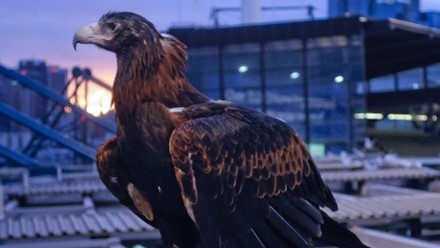How raptors are saving crops – and sports – from pesky corellas

To farmers and greenkeepers at golf courses and other sporting fields, corellas can be a significant menace, wreaking havoc as they destroy the manicured greens and surrounds as hundreds or more of the birds flock for their daily feast.
Federation University ecologist Professor Rob Wallis has been working with industry partner, the Miners Rest-based Full Flight Birds of Prey, to help disperse nuisance bird flocks and reduce the damage they cause to agriculture, sporting complexes and activities and infrastructure.
His role in the partnership is largely research-based and work that includes animal welfare and began when he was approached by colleagues who were keen to explore methods of controlling corellas that were more humane than techniques being used at that time.
"The alternative for people controlling pests is you apply for one-off permits from the government each time. So, for example, if kangaroos are causing damage to fences or pastures on properties, farmers could engage a kangaroo shooter, but they would need to apply for a permit every single time," Professor Wallis said.
"My research partners wanted a long-term and scientifically based approach to their work."
Professor Wallis then linked up with Full Flight Birds of Prey Director Graeme Coles. Mr Coles hand-breeds and rears birds of prey, and the research project, which also includes other government and raptor specialist partners, became the first of its type in Australia to scientifically evaluate how the presence of trained birds of prey – or raptors – influenced nuisance birds in agricultural and urban landscapes.
They have successfully dispersed seagulls at the Melbourne Cup Carnival for many years and parrots from buildings, including a railway storage facility where extensive damage to insulators had been caused. The raptors have also been used at the Australian Open tennis grand slam tournament and school grounds.
"I became involved as the person to advise on scientific protocols, helping with the animal ethics approvals and subsequently wildlife research approvals to government, and to also assist in publishing the findings," Professor Wallis said.
The process involves the non-lethal management of pest birds, including corellas, sulphur-crested cockatoos and seagulls. In the natural situation, the predator scares the target bird flocks for a brief period. The scientists then monitor how the birds react to the threat.
Natural predators
Importantly, the technique raises fewer ethical concerns than current practices for pest bird damage mitigation, such as poisoning and shooting. Professor Wallis says the raptors are natural predators of the nuisance birds, making the exercise an entirely natural management process. Other techniques commonly tried, such as scare guns and models, do not work as the target birds quickly habituate to the initially perceived threat.
There have been successes at sporting venues and events, including the Melbourne Cup Carnival where a peregrine falcon has been released to disperse seagulls at the beginning of each race. Flocks of gulls can spook horses and cause severe economic and health and safety consequences.
"At the beginning of the day, there are very few seagulls there, but they arrive when the crowd comes in and start to drop food. The horses run and we assess when the seagulls have come back in time for the next race. Usually they are beginning to flutter back, so you send another falcon off," Professor Wallis said.
The process has also seen successes at golf courses in Ballarat and Melbourne where birds can cause enough damage to greens to make the courses unplayable and cost the clubs significant damage to their facilities and revenues.
"We're building up a dossier of what's likely to work that we can take to clients. We say we can't guarantee success but here's some evidence of successes we've had in the past," Professor Wallis said.
"My role in the partnership is to document and put everything in a scientific context so that we can give more certainty to clients about what would likely work."
Professor Rob Wallis
Other successes include a trial completed for a multinational agribusiness group that owns large almond farms near the Murray River.
"They were concerned because corellas were coming in at harvest time, eating lots of the almonds, and they're messy eaters – they'll pick an almond, have a chunk of it and drop the rest on the ground," Professor Wallis said.
"This time Graeme flew an eagle over their flight path – we were concerned because it's a big area and we thought all would happen is the corellas would move a bit further up the farm. But that didn't happen – they went for the safety of the trees on the river.
"The beauty of this project was that harvesting took about three to four weeks and at the end, the corellas began to drift back and clean up all the rubbish on the ground. So it was quite a good strategy.
"It can work for big companies, it has worked for the Victoria Racing Club and a lot of the golf clubs are willing to do it now, given that we've had some pretty high successes and word is getting around."
Professor Wallis said the next phase of their work was looking at using the raptors inside buildings. The group has lodged an application for a project to consider where the raptors can be used at indoor sites like food warehouses and silos where sparrows and swallows congregate.
"I would be interested to see whether we could expand that as an activity using different species of birds of prey and also proposing a series of solutions like exclusion devices so these birds can't get in in the first place."
In June last year, the group presented their work at the 28th International Sustainable Development Research Society's conference held in Stockholm and was subsequently asked to write a chapter in a forthcoming Routledge-published book on achieving sustainable development goals.